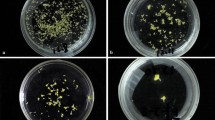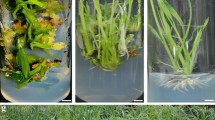Abstract
This paper describes a new protocol to develop doubled-haploid (DH) Brassica napus lines with improved resistance to Sclerotinia sclerotiorum. In this protocol, haploid seedlings derived from microspore cultures of B. napus were used to produce haploid calli for in vitro mutation-selection. For routine screening, mutation was induced by EMS (ethylmethane sulfonate) or occurred spontaneously, and screening for resistant mutants occurred on media with added oxalic acid (OA) as a selection agent. In tests with selected lines, the optimal concentration of EMS for mutation was determined to be 0.15%, and the optimal concentration of OA for in vitro screening was 3 mmol/l (half lethal dose was 3.1 mmol/l) for the first cycle of screening. There was an accumulated effect of OA toxicity on calli over two cycles of screening, but the growth and capacity of the surviving calli for regenerating seedlings were not affected by OA. Of the 54 DH lines produced from the in vitro mutation-selection, two DH lines of resistant mutants, named M083 and M004, were selected following seedling and glasshouse tests. The resistance of M083 and M004 to S. sclerotiorum following tests with both mycelial inoculum and OA was greater than that of their donor lines and the resistant control Zhongyou 821. In both glasshouse and field disease nurseries, disease indices on M083 and M004 were less than 50% of those of the control. The time required for M083 and M004 to mature was 14 days and 10 days shorter, respectively, than that of their donor lines. Furthermore, M083 had more pods per inflorescence, a greater 1,000 seed weight and higher yield than its donor line. Random amplified polymorphic DNA characterisation showed that M083 had DNA band patterns that differed from its donor line.



Similar content being viewed by others
Abbreviations
- BAP:
-
6-Benzylaminopurine
- DH:
-
Double haploid
- EMS:
-
Ethylmethane sulfonate
- NAA:
-
α-Naphthaleneacetic acid
- OA:
-
Oxalic acid
- 2,4-D:
-
2,4-Dichlorophenoxyacetic acid
References
Ahmad I, Day JP, MacDonald MV, Ingram DS (1991) Haploid culture and UV mutagenesis in rapid-cycling Brassica napus for the generation of resistance to chlorsulfuron and Alternaria brassicicola. Ann Bot 67:521–525
Auld DL, Heikkinen MK, Erickson DA, Sernyk JL, Romero JE (1991) Rapeseed mutants with reduced levels of polyunsaturated fatty acids and increased levels of oleic acid. Crop Sci 32:657–662
Bansal VK, Thiagarajah MR, Stringam GR, Hardin RT (1998) Haploid plantlet-screening in the development of blackleg resistant DH lines of Brassica napus. Plant Breed 117:103–106
Barro F, Fernandez-Escobar J, De La Vega M, Martin AM (2001) Doubled haploid lines of Brassica carinata with modified erucic acid content through mutagenesis by EMS treatment of isolated microspores. Plant Breed 120:62–64
Cessna SG, Sears VE, Dickman MB, Low PS (2000) Oxalic acid, a pathogenicity factor for Sclerotinia sclerotiorum, suppresses the oxidative burst of the host plant. Plant Cell 12:2191–2199
Coventry J, Kott L, Beversdorf WD (1988) Manual for microspore culture technique for Brassica napus. OAC Publ 0489, Technical Bulletin, Crop Science, University of Guelph, Guelph, Ontario
Druka A, Kudrna D, Kannangara CG, Wettstein DV, Kleinhofs A (2002) Physical and genetic mapping of barley (Hordeum vulgare) germin-like cDNAs. Proc Natl Acad Sci USA 99:850–855
Gamborg OL, Miller RA, Ojima L (1968) Nutrient requirements of suspension cultures of soybean root cells. Exp Cell Res 50:151–158
Godoy G, Steadman JR, Dickman MB, Dam R (1990) Use of mutants to demonstrate the role of oxalic acid in pathogenicity of Sclerotinia sclerotiorum on Phaseolus vulgaris. Physiol Mol Plant Pathol 37:179–191
Karp A (1995) Somaclonal variation as a tool for crop improvement. Euphytica 85:295–302
Kesarwani M, Azam M, Natarajan K, Mehta A, Datta A (2000) Oxalate decarboxylase from Collybia velutipes-Molecular cloning and its overexpression to confer resistance to fungal infection in transgenic tobacco and tomato. J Biol Chem 275:7230–7238
Kott L, Wong R, Swanson E, Chen J (1996) Mutation and selection for improved oil and meal quality in Brassica napus utilizing microspores culture. In: Jain SM, Sopory SK, Veilleux RE (eds) In vitro haploid production in higher plants, vol 2. Springer, Berlin Heidelberg New York, pp 151–167
Liu S, Zhou B, Yu Q, Zhou L (1998a) Application of oxalic acid for screening resistance of oilseed rape to Sclerotinia sclerotiorum and its affecting factors. Acta Phytophylacica Sin 25:56–60
Liu S, Pan J, Zhou B (1998b) Uptake, metabolism of oxalate by and mechanism of resistance to Sclerotinia disease in oilseed rape. Acta Phytopathologica Sin 28:18–23
MacDonald MV, Ingram DS (1986) Toward the selection in vitro for resistance to Alternaria brassicicola (Schw) Welts., in Brassica napus ssp. Oleifera (Metzg.) Sinsk., winter oilseed rape. New Phytol 104:621–629
Maluszynski M, Ahloowalia BS, Sigurbjornsson B (1995) Application of in vivo and in vitro mutation techniques for crop improvement. Euphytica 85:303–315
Murashige T, Skoog F (1962) A revised medium for rapid growth and bioassays with tobacco tissue cultures. Physiol Plant 15:473–497
Newsholme DM, MacDonald MV, Ingram DS (1989) Studies of selection in vitro for novel resistance to phytotoxic products of Leptospheria maculans (Desm.) Ces.& De Not in secondary embryogenic lines of Brassica napus ssp. oleifera (Metzg.) Sinsk., winter oilseed rape. New Phytol 113:117–126
Noyes RD, Hancock JG (1981) Role of oxalic acid in the Sclerotinia wilt of sunflower. Physiol Plant Pathol 18:123–132
Polsoni L, Kott LS, Beversdorf WD (1988) Large-scale microspore culture technique for mutation-selection studies in Brassica napus. Can J Bot 66:1681–1685
Sacristan MD (1982) Resistance response to Phoma lingam of plants regenerated from selected cell and embryogenic cultures of haploid Brassica napus. Theor Appl Genet 61:193–200
Sedun FS et al. (1989) Genetic variations in reaction to Sclerotinia stem rot in Brassica species. Can J Plant Sci 69:229–232
Shi S, Wu J, Liu H (1995) In vitro mutation for long pod and short plant. Nucleic Agric 9:252–253
Swanson EB, Coumans MP, Brown GL, Patel JD, Beversdorf WD (1988) The characterization of herbicide tolerant plants in Brassica napus L. after in vitro selection of microspores and protoplasts. Plant Cell Rep 7:83–87
Swanson EB, Herrgesell MJ, Arnoldo FM, Sippell DW, Wong RSC (1989) Microspore mutagenesis and selection: canola plants with field tolerance to the imidazolinones. Theor Appl Genet 78:525–530
Zhou B, Chen D, Yu Q, Liu S, Yang J (1993) Screening and breeding for multiple resistance to Sclerotinia stem rot, downy mildew and virus disease. Chinese J Oil Crops 16:14–17
Zhou L, Yu Q, Liu S, Zhou B, Wang C (1994) Resistance evaluation of rapeseed germplasm. Chinese J Oil Crops 17[Suppl]:69–72
Zhou Y, Lin Z, Dong J (1998) Recurrence selection in Brassica napus IV. Efficiency of selection for resistance to Sclerotinia sclerotiorum J Huazhong Agric Univ 17:312–316
Acknowledgements
The work was supported by the National Natural Science Foundation of China (No. 39830270) and China National Project on Biotechnology (No. 96C-01-01-06). Rothamsted Research is supported by the UK Biotechnology and Biological Sciences Research Council. We thank Prof. Tingdong Fu at Huazhong Agricultural University and Professor Biwen Zhou at the CAAS Institute of Oil Crops Research for their critical reading of the Chinese version of the manuscript, and Prof. John Lucas at Rothamsted Research for his comments on the manuscript. Assistance from Prof. Dezhi Du and Ms. Xiuping Li at Qinghai Hybrid Rapeseed Research Centre is acknowledged
Author information
Authors and Affiliations
Corresponding author
Additional information
Communicated by M.R. Davey
Rights and permissions
About this article
Cite this article
Liu, S., Wang, H., Zhang, J. et al. In vitro mutation and selection of doubled-haploid Brassica napus lines with improved resistance to Sclerotinia sclerotiorum. Plant Cell Rep 24, 133–144 (2005). https://doi.org/10.1007/s00299-005-0925-0
Received:
Revised:
Accepted:
Published:
Issue Date:
DOI: https://doi.org/10.1007/s00299-005-0925-0




